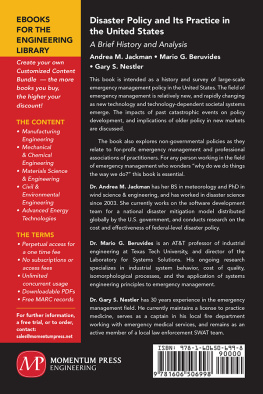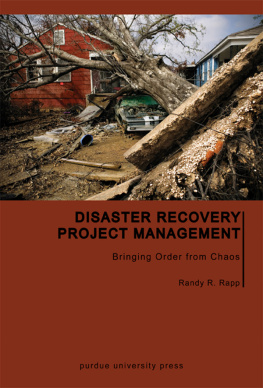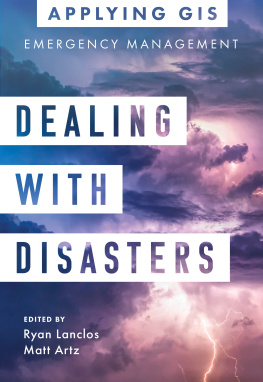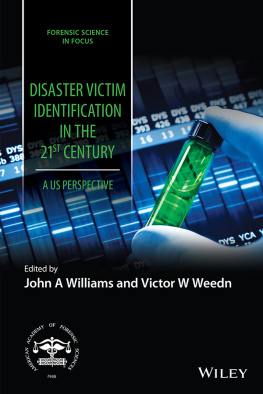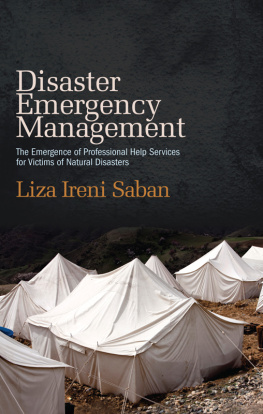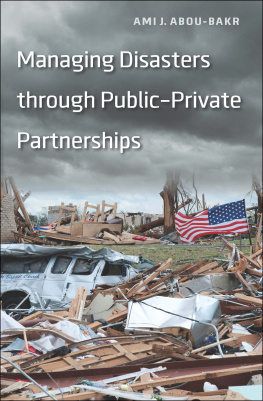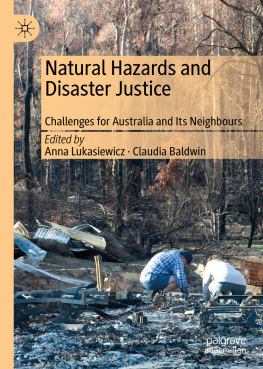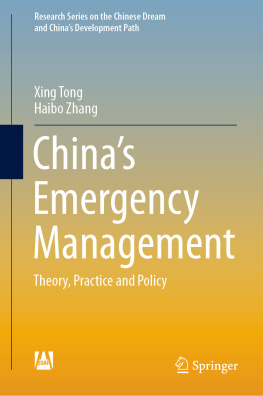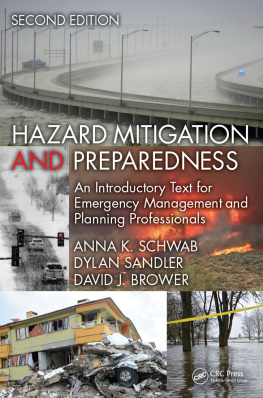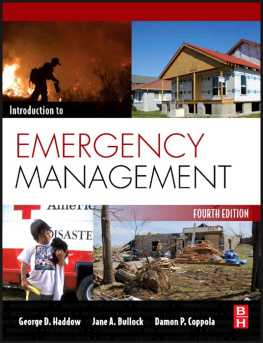
DISASTER
POLICY AND ITS
PRACTICE IN THE
UNITED STATES
DISASTER
POLICY AND ITS
PRACTICE IN THE
UNITED STATES
A BRIEF HISTORY
AND ANALYSIS
ANDREA M. JACKMAN,
MARIO G. BERUVIDES, AND
GARY S. NESTLER

Disaster Policy and Its Practice in the United States: A Brief History and Analysis
Copyright Momentum Press, LLC, 2017.
All rights reserved. No part of this publication may be reproduced, stored in a retrieval system, or transmitted in any form or by any meanselectronic, mechanical, photocopy, recording, or any otherexcept for brief quotations, not to exceed 400 words, without the prior permission of the publisher.
First published by Momentum Press, LLC
222 East 46th Street, New York, NY 10017
www.momentumpress.net
ISBN-13: 978-1-60650-699-8 (print)
ISBN-13: 978-1-60650-700-1 (e-book)
Momentum Press Industrial and Systems Engineering Collection
Collection ISSN: 2372-3564 (print)
Collection ISSN: 2372-3572 (electronic)
Cover and interior design by Exeter Premedia Services Private Ltd., Chennai, India
10 9 8 7 6 5 4 3 2 1
Printed in the United States of America
ABSTRACT
Emergency management and the study of disasters is a relatively young industry, beginning in its current form only after the World Wars of the previous century. Yet with the ever-increasing complexity of society in the Digital Age, the management and recovery from disasters in recent years have received more attention than ever. In a field traditionally belonging to the military and social sciences, the authors of this book review existing policy and standard practices within emergency management from an industrial and systems engineering perspective. The book explores both the contextual history of managing disasters in the United States, both at the national and local level, and describes how these events influenced federal policy development in the latter half of the 20th century. Compliance with this policy, and existing challenges with 21st century technology, is further explored, along with recommendations for future policy directions. Practitioners of emergency management, and academic researchers who ask the question is our policy working? should find the text relevant to their endeavors.
KEYWORDS
cost of policy, cost of quality, disaster management, emergency management, federal government, industrial engineering, systems engineering, legislation, mitigation, planning, policy design, policy, preparedness, quality measures, recovery, response, workforce professionals
1.1 WHY EMERGE NCY MANAGEMENT? AN INTRODUCTION BY ANDREA JACKMAN
A hundred years ago, the field of emergency management did not exist. The same can be said for many other disciplines that arose in the 20th century, as well as technological advances and products of the rapid modernization and eventual digitization of our society. Yet, our field becomes more critical with each of the advancements in both society and technology. The more advanced systems we have to support our daily lives, the more tightly these systems become interwoven, and the more our dependence on them grows. What might have been an unreported non-incident a hundred years agoa minor flood or loss of telephone linescould today cause significant disruption and be broadcast globally through online media. Studying our management of such disruptions is essential, and a policy provides a measuring stick by which to do just that. As this book will show, the implementation of an existing policy provides a chance to measure our progress, and the development of a new policy provides an opportunity to shape our reactions.
When I was eight years old, my family lived in Hiroshima, Japan. My parents and I lived in a fifth floor apartment in a residential neighborhood of one of the safest and most orderly countries in the world. One weekend in the fall, my mother and her friend planned to take a trip to another city to do some shopping. The weather forecast called for a miserable, windy, and rainy fall daya mild typhoon was near the coastso she planned to be on the train and indoors while my father and I stayed home.
As the end of the weekend got closer, the forecast changed. The typhoon had strengthened, and was likely to come ashore. Dad and I kept an eye on the sky from our apartment as clouds darkened, the wind picked up, and a steady rain started to fall. Nobody seemed particularly alarmed, although this was years before the Internet and 24-hour news cycle that surrounds hurricanes and typhoons today. My father had some fluency in Japanese and tried to pick up bits and pieces of information from television and radio, as well as the police officer with a megaphone driving down the street giving instructions for staying safe. My mom, who had already boarded her return train, found that it was not moving as quickly as usual and she thought they might be late getting back to Hiroshima stationsomething very unusual on the high-precision bullet trains.
The sun went down as the storm picked up, and Dad and I watched sheets of rain, and occasional pieces of corrugated roofing, blow sideways down the street. The wind rattled our windows and blew the screens back and forth, making loud banging noises. Never a fan of startling noises or severe weather to begin with, I was getting more and more uneasy as the evening went on. The husband of my moms friend phoned us to say he was going to try to get to the train station, just down the hill from their house, to try to get some information about the trains and see about picking up his wife and my mom on what was clearly going to be a late arrival. My mom and her friend, meanwhile, were experiencing intermittent power outages on the train, which had stopped moving. They were able to piece together bits of announcements from the train conductor to figure out that they were parking in a tunnel for the night until the train could proceed safely. Years later, the two women enjoy telling the story of how they found the last bit of food available on board and shared it: a stale tray of noodle salad and a warm beer.
Back in Hiroshima, it was getting close to midnight, and there was nothing left for us to do but try and get some sleep. Dad brought me into his room and tucked me in bed while he sat up watching the weather outside. I woke up a few hours later in pitch darkness, with no memory of having fallen asleep. My dad was gone. Not just gone to sit in the living room, but gone from the apartment. I looked for him and realized the power was out. Trying to calm myself down, I thought perhaps he had gone to get my mom. My mom! Where was she? Was she safe? Had my dad tried to get her and something happened? I picked up the phone and started to dial our friends house to see if they were there, but the phones were out along with the power. Feeling helpless and terrified, I thought the best thing I could do was stay locked in the apartment and wait, under the safety of a few blankets, and hope none of the larger bits of flying debris smashed through the window.
I woke up early in the morning to find both my parents returned. My moms bullet train had limped into Hiroshima station around 4 a.m. as the storm was dying down. My dad had gone to get her, but failed to wake me up or leave a note explaining his absence, much to my moms and my own horror. We were safe and unharmed, but were soon evacuated to a hotel when it was discovered our neighborhood would be without water, power, or phone service for the next few days.
Next page
